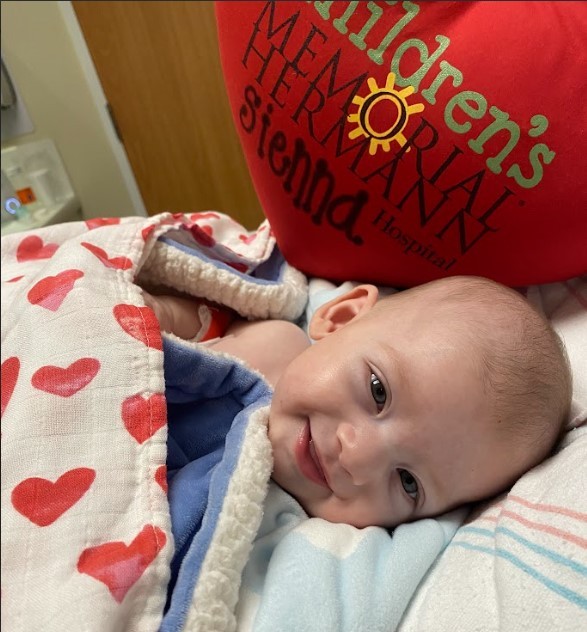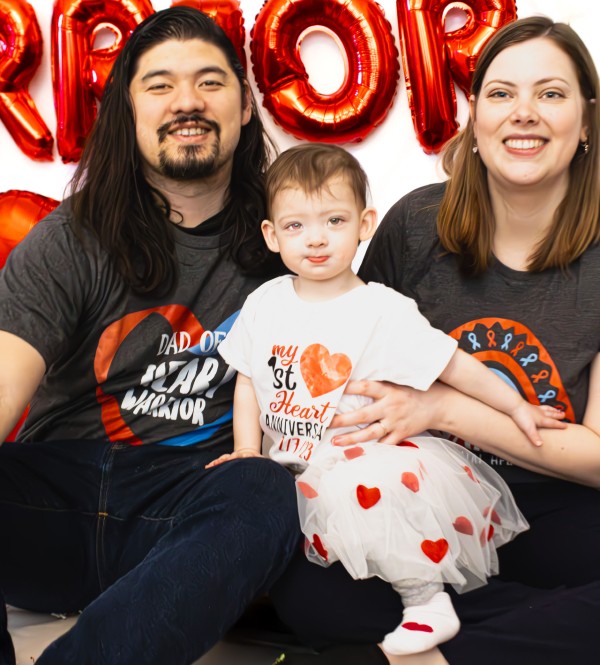Surgery for Tetralogy of Fallot unleashes the full potential of Sienna Wilson’s brain

When Sienna Grace Wilson was born, a little fighter came into the world. Her parents, Sarah and David Wilson, were in awe of their new baby. They were also very emotional because of Sienna’s pre-birth diagnosis of Tetralogy of Fallot. Sarah’s research weighed heavily on their minds. That’s because Sarah Lund Wilson is a pediatric neurologist here in the Department of Pediatrics at McGovern Medical School. She focuses on protecting the pediatric brain and researches the impact of cyanosis, or decreased oxygen in the blood stream, associated with heart defects on brain development and overall cognition. Among her research mentors is Jorge Salazar, MD, professor of Pediatric and Congenital Heart Surgery at McGovern Medical School and executive director of the Children’s Heart Institute at Children’s Memorial Hermann Hospital.
“Here, we have a relatively new attending physician who is very concerned that low oxygen saturation in the newborn period causes brain injury. Then, she learns that her first child will be born with low oxygen saturation,” Dr. Salazar says. “Sarah was very blunt with me and asked, ‘Is my child’s brain going to be okay?’ I said, ‘Sarah, I have really good news for you. Not only is your child going to be okay, but she will thrive.’”
A Fateful Diagnosis
At her 20-week ultrasound, Dr. Wilson and her husband David learned that their baby had an anomaly. Her friend Rachel Wiley, MD, an obstetrician and assistant professor in the Ob/Gyn Department at McGovern Medical School, recommended she connect with Jerrie Refuerzo, MD, a maternal-fetal medicine specialist and professor in the Ob/Gyn Department at McGovern.
Dr. Refuerzo met with Dr. Wilson and her husband at The Fetal Center at Children’s Memorial Hermann Hospital where Dr. Wilson underwent a fetal echocardiogram that revealed Tetralogy of Fallot(ToF) in her unborn baby. This heart diagnosis is a complex, congenital (present at birth) heart condition involving four related heart defects that commonly occur together. With ToF, a patient typically has a ventricular septal defect (VSD) – a hole between the heart’s main pumping chambers; plus pulmonary stenosis, where the valve between the heart and lungs blocks normal blood flow from the heart ventricle to the lungs; and extra thick heart walls; finally, the patient’s aorta, the main blood vessel leading from the heart to the body, is in the wrong location.
“Unlike most of the patients who come to The Fetal Center without extensive knowledge about their baby’s condition, Sarah had enough knowledge to make her worry even more,” Dr. Refuerzo says. “She is absolutely wonderful, one of the kindest and most caring and most giving people I’ve met. She was nervous and worried, and despite her knowledge, asked the appropriate questions and followed the recommendations of all her specialists up to and through delivery. She was always cautiously optimistic.”
For patients with a fetal heart diagnosis, The Fetal Center team partners with the Children’s Heart Institute at Children’s Memorial Hermann to provide care for complex cases, such as Sienna’s. The teams talked with Sarah and David about the plan for the reminder of her pregnancy, the new baby’s delivery and post-birth care treatments. Through these conversations, the family asked Dr. Salazar to be the heart surgeon for their baby girl.
Advanced Care
Throughout her pregnancy, Dr. Wilson continued to see her own patients and progressed through her research on the impact of a heart condition on a baby or child’s brain. She was thinking of her soon-to-be-born baby girl Sienna the whole time.
It was a lot for Dr. Wilson and David, but Dr. Salazar was a great comfort to the growing family. “We understand so much more now about how conditions and procedures can potentially impact a child’s neurodevelopmental future than we did when I started out 20 years ago,” Dr. Salazar says. “We’ve learned during which periods of development the risk is greatest and how to avoid those risks, a lot of which occurs during surgery. We use technology and advanced techniques that we’ve helped discover to protect the brain while we perform heart repairs. Together, The Fetal Center and the Children’s Heart Institute have taken these advances and applied them so that we can offer care to babies with the most complex heart conditions, like Sienna. The brain depends on good oxygen delivery from the heart and lungs. The better the heart and lungs function, the better the brain operates. With heart surgery, we don’t hurt the baby’s brain. We work to unlock its full potential.”
As often occurs in babies with congenital heart disease before birth, Sienna was diagnosed with intrauterine growth restriction. “A congenital heart condition can affect the baby’s growth during pregnancy,” Dr. Refuerzo says. “We do ultrasounds and plot out a growth curve for each baby. Ideally, babies who will need heart surgery should be born at 39 weeks’ gestation so they are better prepared for surgery after birth, but when their growth slows, the recommendation is to deliver at 37 to 38 weeks’ gestation. We got Sara to 37 weeks’ gestation and then induced delivery, working closely with her affiliated team that included a pediatric cardiologist, pediatric cardiovascular surgeon and fetal interventionalist. It’s a total team effort from beginning to end.”
Sienna’s Birth
Dr. Wilson was in labor for 28 hours, and on October 5, 2022, Sienna entered the world. “The care was excellent, and there were a lot of clinicians checking on both of us,” she says.
Sienna was not breathing immediately after birth and was resuscitated, intubated and moved to the Level IV Neonatal Intensive Care Unit (NICU) at Children’s Memorial Hermann Hospital – where the highest level of advanced and specialized medical care for newborns and premature infants is available.
After a couple of hours, Sienna no longer needed respiratory support. After five days in the NICU working on her feeding, Sienna went home with her parents.
Heart Surgery at 4 Months
At just four months old, Sienna underwent her first surgery with Dr. Salazar as he performed a complete Tetralogy of Fallot repair, closing the VSD with a patch and opening the right ventricular outflow tract. “It was very challenging for David and me to let her go to the OR,” Dr. Wilson says. “We knew she was in excellent hands, but we also were aware of the risks involved. We had confidence in the team, and that gave us hope.”
Now, after repair, Sienna has the right amount of oxygen delivered to her brain from her heart and lungs, which allows for better performance and normal development. Sienna is doing well.
Terrific Twos

“She’s a little energizer bunny,” says David. “She takes swimming lessons, likes to play with the dog and cat, and loves to ride her toy car around the house.”
“I was in my first two months of being an attending pediatric neurologist when I delivered my baby girl,” Dr. Wilson recalls. “I’ve worked for years with so many of the providers and care teams who looked after me and Sienna. I learned a lot from them during this time as both a doctor and as a patient. Now, back at work, I spend part of my time in my job caring for babies after their stay in the NICU. I now have a better understanding of what these parents are going through. That stays with me when I am treating their children.”